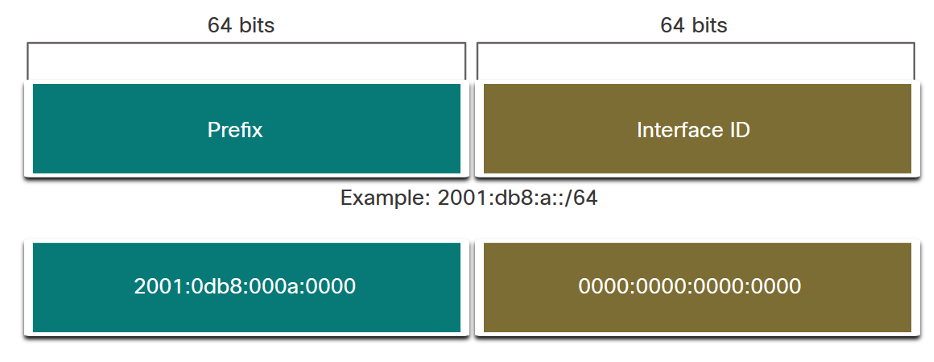
IPv6 Address Types
Compare types of IPv6 network addresses.
Unicast, Multicast, Anycast
There are three broad categories of IPv6 addresses:
- Unicast – Unicast uniquely identifies an interface on an IPv6-enabled device.
- Multicast – Multicast is used to send a single IPv6 packet to multiple destinations.
- Anycast – This is any IPv6 unicast address that can be assigned to multiple devices. A packet sent to an anycast address is routed to the nearest device having that address.
Note: Unlike IPv4, IPv6 does not have a broadcast address. However, there is an IPv6 all-nodes multicast address that essentially gives the same result.
IPv6 Prefix Length
- Prefix length is represented in slash notation and is used to indicate the network portion of an IPv6 address.
- The IPv6 prefix length can range from 0 to 128.
- The recommended IPv6 prefix length for LANs and most other types of networks is /64.

Note: It is strongly recommended to use a 64-bit Interface ID for most networks. This is because stateless address autoconfiguration (SLAAC) uses 64 bits for the Interface ID. It also makes subnetting easier to create and manage.
Types of IPv6 Unicast Addresses
Unlike IPv4 devices that have only a single address, IPv6 addresses typically have two unicast addresses:
- Global Unicast Address (GUA) – This is similar to a public IPv4 address. These are globally unique, internet-routable addresses.
- Link-local Address (LLA) – Required for every IPv6-enabled device and used to communicate with other devices on the same local link. LLAs are not routable and are confined to a single link.

A Note About the Unique Local Address
The IPv6 unique local addresses (range fc00::/7 to fdff::/7) have some similarity to RFC 1918 private addresses for IPv4, but there are significant differences:
- Unique local addresses are used for local addressing within a site or between a limited number of sites.
- Unique local addresses can be used for devices that will never need to access another network.
- Unique local addresses are not globally routed or translated to a global IPv6 address.
Note: Many sites use the private nature of RFC 1918 addresses to attempt to secure or hide their network from potential security risks. This was never the intended use of ULAs.
IPv6 GUA
IPv6 global unicast addresses (GUAs) are globally unique and routable on the IPv6 internet.
- Currently, only GUAs with the first three bits of 001 or 2000::/3 are being assigned.
- Currently available GUAs begins with a decimal 2 or a 3 (This is only 1/8th of the total available IPv6 address space).
IPv6 GUA Structure

- Global Routing Prefix: The global routing prefix is the prefix, or network, portion of the address that is assigned by the provider, such as an ISP, to a customer or site. The global routing prefix will vary depending on ISP policies.
- Subnet ID: The Subnet ID field is the area between the Global Routing Prefix and the Interface ID. The Subnet ID is used by an organization to identify subnets within its site.
- Interface ID: The IPv6 interface ID is equivalent to the host portion of an IPv4 address. It is strongly recommended that in most cases /64 subnets should be used, which creates a 64-bit interface ID.
Note: IPv6 allows the all-0s and all-1s host addresses can be assigned to a device. The all-0s address is reserved as a Subnet-Router anycast address, and should be assigned only to routers.
IPv6 LLA
An IPv6 link-local address (LLA) enables a device to communicate with other IPv6-enabled devices on the same link and only on that link (subnet).
- Packets with a source or destination LLA cannot be routed.
- Every IPv6-enabled network interface must have an LLA.
- If an LLA is not configured manually on an interface, the device will automatically create one.
- IPv6 LLAs are in the fe80::/10 range.

Other related topics
| Topic Title | Topic Objective |
|---|---|
| IPv4 Issues | Explain the need for IPv6 addressing. |
| IPv6 Address Representation | Explain how IPv6 addresses are represented. |
| IPv6 Address Types | Compare types of IPv6 network addresses. |
| GUA and LLA Static Configuration | Explain how to configure static global unicast and link-local IPv6 network addresses. |
| Dynamic Addressing for IPv6 GUAs | Explain how to configure global unicast addresses dynamically. |
| Dynamic Addressing for IPv6 LLAs | Configure link-local addresses dynamically. |
| IPv6 Multicast Addresses | Identify IPv6 multicast addresses. |
| Subnet an IPv6 Network | Implement a subnetted IPv6 addressing scheme. |